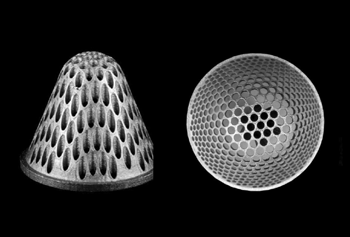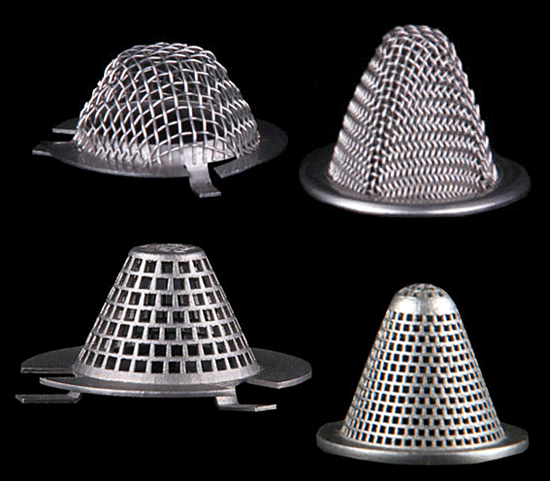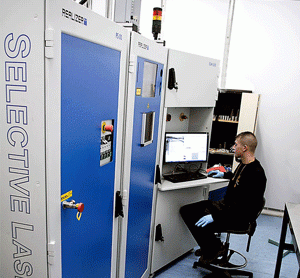Additive Manufacturing and filtration: Innovations in filter design at Croft
September 8, 2014
Croft Filters, a leading filter manufacturer based in Warrington, UK, produces filtration components for multiple industries using a range of subtractive techniques including CNC punching and machining. The company recently identified a significant opportunity in using Additive Manufacturing (AM) technology to reduce energy usage and produce components that could not be created using any other method. In 2013 Croft Filters invested almost £500,000 in a Realizer SLM-250 AM machine and launched specialist company Croft Additive Manufacturing (CAM).
The Realizer SLM-250 (Fig. 1) enables unique and previously unattainable metal components and assemblies to be designed and produced directly from 3D CAD data. Having previously only used subtractive methods, CAM focused on exploring the design possibilities of AM to improve aerodynamics and energy usage in filtration.
Collaborative research
To support the company’s investment in an AM machine, and further drive its research and development, it worked with a number of partner organisations. In 2013, CAM was selected as the first company to join the Science and Technology Facilities Council (STFC) CERN Business Incubation Centre (STFC CERN BIC). The centre, which marks a partnership between the STFC and CERN, the world’s leading particle physics laboratory, aims to bridge the gap between science and industry, and drive UK commerce. CAM was selected for its application of innovative technology and commitment to developing this technology. The innovative scheme has given CAM direct access to key technologies and collaborative opportunities at both STFC and CERN. This collective approach to product design has enabled the business to improve its day-to-day use of AM while pushing the boundaries of future applications.

direction of fluid flow require lower pressure pumps, saving
energy and reducing costs
In addition to this, CAM has undertaken a three year project with the UK’s Lancaster University. Part-funded by the European Development Fund, the project aims to use AM technology to improve the geometry of filter supports, ultimately saving energy and costs. R&D focuses on testing the flow rate and difference in pressure drops of AM filters compared to conventionally manufactured filters. Through this research, experts have found that a filter’s holes can be aligned in the direction of the flow, helping to increase operational efficiency across the filter and extend its product lifetime (Fig. 2).
Filtration innovation
While these partnerships focus on long-term aims, CAM’s in-house experts are continually researching practical changes that can be made now using AM. For instance, CAM has used AM to revolutionise the design of stainless steel 316 filters, which remove contaminants found in pipe lines.
By applying AM techniques, CAM has been able to manufacture highly efficient components, creating a complex filter which offers a higher flow rate than its standard counterpart. Ultimately, this means fluid can be pumped with a lower pressure drop over the filter. As a result, an optimum rate of performance is maintained for a longer period of time, extending the lifespan of the filtration unit, and reducing operating costs for the end-user. This is just one example of the many potential applications of AM technology within industry and the opportunities it offers for improving operational efficiencies.

Fig. 3 Woven wire mesh filter (top) distorts aperture size and shape when moulded. The
equivalent AM filters can maintain aperture size and shape
Looking ahead
In the age of new technology, advancements are more fast-paced than ever. For instance, desktop 3D printers are now available for consumer purchase and even the food industry has seen a rise in edible 3D printing technology. However, as manufacturing needs diversify, AM has the potential to offer new design opportunities to the sector.
In the filtration industry, AM has the potential to revolutionise filtration solutions and offer a greater level of customer specification options. CAM are continually exploring ways in which conventional parts can be combined with AM products to reduce the cost of replacing entire units while still improving operational efficiencies.
As well as product innovation, AM offers businesses the opportunity to expand into overseas markets. In the future, those businesses that are open to exploring alternative technologies will be able to expand design possibilities and outpace competitors.
www.additive-manufacture.co.uk
Subscribe to our FREE e-newsletter
Useful links: News | Articles | Introduction to metal Additive Manufacturing

















